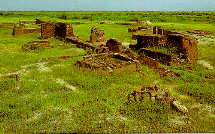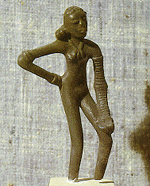The Indus Valley
Civilisation
Settlements
Urban
Development
Occupations
Society and
Religion

Settlements
From the beginning of the 4th millennium BC,
the individuality of the early village cultures
began to be replaced by a more homogenous style
of existence. By the middle of the 3rd
millennium, a uniform culture had developed at
settlements spread across nearly 500,000 square
miles, including parts of Punjab, Uttar Pradesh,
Gujarat, Baluchistan, Sind and the Makran
coast.
This earliest known civilisation in India, the
starting point in its history, dates back to
about 3000 BC. Discovered in the 1920s, it was
thought to have been confined to the valley of
the river Indus, hence the name given to it was
Indus Valley civilisation. This civilisation was
a highly developed urban one and two of its
towns, Mohenjodaro and Harappa, represent the
high watermark of the settlements. Subsequent
archaeological excavations established that the
contours of this civilisation were not restricted
to the Indus valley but spread to a wide area in
northwestern and western India. Thus this
civilisation is now better known as the Harappan
civilisation. Mohenjodaro and Harappa are now in
Pakistan and the principal sites in India include
Ropar in Punjab, Lothal in Gujarat and Kalibangan
in Rajasthan.

Urban Development
The emergence of this civilisation is as
remarkable as its stability for nearly a thousand
years. All the cities were well planned and were
built with baked bricks of the same size; the
streets were laid at right angles with an
elaborate system of covered drains. There was a
fairly clear division of localities and houses
were earmarked for the upper and lower strata of
society. There were also public buildings, the
most famous being the Great Bath at Mohenjodaro
and the vast granaries. Production of several
metals such as copper, bronze, lead and tin was
also undertaken and some remnants of furnaces
provide evidence of this fact. The discovery of
kilns to make bricks support the fact that burnt
bricks were used extensively in domestic and
public buildings.

Occupations
 Evidence also
points to the use of domesticated animals,
including camels, goats, water buffaloes and
fowls. The Harappans cultivated wheat, barley,
peas and sesamum and were probably the first to
grow and make clothes from cotton.Trade seemed to
be a major activity at the Indus Valley and the
sheer quantity of seals discovered suggest that
each merchant or mercantile family owned its own
seal. These seals are in various quadrangular
shapes and sizes, each with a human or an animal
figure carved on it. Discoveries suggest that the
Harappan civilisation had extensive trade
relations with the neighbouring regions in India
and with distant lands in the Persian Gulf and
Sumer (Iraq). Evidence also
points to the use of domesticated animals,
including camels, goats, water buffaloes and
fowls. The Harappans cultivated wheat, barley,
peas and sesamum and were probably the first to
grow and make clothes from cotton.Trade seemed to
be a major activity at the Indus Valley and the
sheer quantity of seals discovered suggest that
each merchant or mercantile family owned its own
seal. These seals are in various quadrangular
shapes and sizes, each with a human or an animal
figure carved on it. Discoveries suggest that the
Harappan civilisation had extensive trade
relations with the neighbouring regions in India
and with distant lands in the Persian Gulf and
Sumer (Iraq).

Society and Religion
The Harappan society was probably divided
according 
to occupations and this also suggests the
existence of an organized government.
The figures of deities on seals indicate that the
Harappans worshipped gods and goddesses in male
and female forms and has also evolved some
rituals and ceremonies. No monumental sculpture
survives, but a large number of human figurines
have been discovered, including a steatite bust
of a man thought to be a priest, and a striking
bronze dancing girl. Countless terra-cotta
statues of Mother Goddess have been discovered
suggesting that she was worshipped in nearly
every home.
By about 1700 BC, the Harappan culture was on
the decline, due to repeated flooding of towns
located on the river banks and due to ecological
changes which forced agriculture to yield to the
spreading desert. Some historians do not rule out
invasions by barbarian tribes of the northwest as
the cause of the decline of the Harappan
civilisation. When the initial migrations of the
Aryan people into India began about 1500 BC, the
developed Harappan culture had already been
practically wiped out.

|